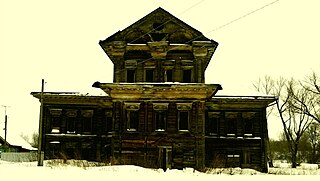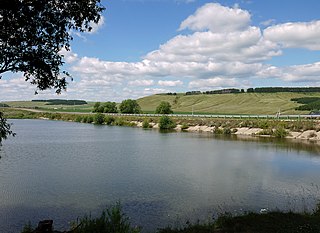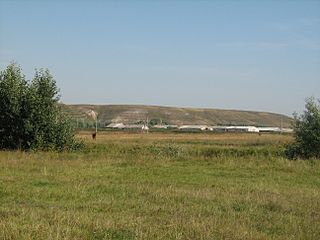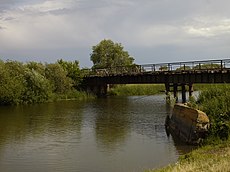
Aktanyshsky District is an territorial administrative unit and municipal district of the Republic of Tatarstan within the Russian Federation. The district is located in the north-east of the republic.

Alexeyevsky District is a territorial administrative unit and municipal district of the Republic of Tatarstan within the Russian Federation. It is located in the central part of the region, on the left bank of the Kama river. The administrative center of the district is the urban-type settlement of Alekseevskoe.

Alkeyevsky District is a territorial administrative unit and municipal district of the Republic of Tatarstan located within the Russian Federation. The total land area of the Alkeyevsky District is 1726,8 km2. The district includes 70 urban and 21 rural settlements. The administrative center is the village of Bazarnye Mataki. As of 2020, 18,675 people resided in the district.

Atninsky District is a territorial administrative unit and municipal district of the Republic of Tatarstan within the Russian Federation. The district is located in the northwest of the republic. The territory of the district includes 47 settlements, which are united into 12 rural settlements. As of 2020, 12 883 people reside in the district. The administrative center is the village of Bolshaya Atnya, founded during the period of the Khanate of Kazan.

Aznakayevsky District is a territorial administrative unit and municipal district of the Republic of Tatarstan within the Russian Federation. The district is located in the southeast part of the republic. As of 2020, 60,129 people resided in the district. Of these 4,264 resided in urban settlements and 17,482 in rural settlements.

Buinsky District is a territorial administrative unit and municipality of the Republic of Tatarstan within the Russian Federation. The district is located in the southwest of the republic and occupies a total area of 1,543 square kilometers (596 sq mi). According to the 2010 census, the municipality had a population of 25,101. As of the beginning of 2020, the population had grown to 41,587. The district currently consists of 98 settlements.

Kaybitsky District is a territorial administrative unit and municipality of the Republic of Tatarstan within the Russian Federation. The territory of the district includes 57 settlements and 17 rural settlements. Тhe district population was 13,415 at the beginning of 2020. The administrative center is the village of Bolshiye Kaybitsy.

Kukmorsky District is a territorial administrative unit and municipality of the Republic of Tatarstan within the Russian Federation. The district is located in the north of the republic and occupies a total area of 1,493 square kilometers (576 sq mi). According to the 2010 census, the municipality had a population of 52,021. As of 2020, the district population was 51,567 people. The administrative center of the district is the urban-type settlement of Kukmor which accounts for 32.5% of the district's total population.

Laishevsky District – is a territorial administrative unit and municipal district of the Republic of Tatarstan within the Russian Federation. It is located in the western part of the republic at the confluence of the Volga and Kama rivers. The administrative center of the district is the city of Laishevo.

Mamadyshsky District is a territorial administrative unit and municipality of the Republic of Tatarstan within the Russian Federation. The district is located in the north of the republic and encompasses an area of 2,600 square kilometers (1,000 sq mi). According to the 2010 census, the municipality had a population of 45,005. The administrative center of the district is the town of Mamadysh, which accounts for 32.1% of the district's total population.

Mendeleyevsky District is a territorial administrative unit and municipal district of the Republic of Tatarstan within the Russian Federation. The district is located on the right bank of the Kama and on the Toyma River, 238 kilometers from Kazan. The administrative center of the district is Mendeleyevsk. At the beginning of 2020, the population of the district was 30,064.

Menzelinsky District is a territorial administrative unit and municipal district of the Republic of Tatarstan within the Russian Federation. The district is located on the right bank of the Kama River, in the north-eastern part of the Republic of Tatarstan. The administrative center is Menzelinsk.

Pestrechinsky District is a territorial administrative unit and municipal district of the Republic of Tatarstan within the Russian Federation. The district is socio-economically developed municipal district with a total area of 1361 m2 located in the north-western region of the Republic of Tatarstan. The administrative center of the district is Pestretsy, a rural locality. In 2019, the district had population of 45,054 people. The Pestrechinsky District is one of the most important agricultural regions of Tatarstan. The main sectors of the district economy are meat and dairy cattle breeding, poultry farming, horse breeding, and animal husbandry in general.

Sarmanovsky District is a territorial administrative unit and municipality of the Republic of Tatarstan within the Russian Federation. It is located in the east of the Republic of Tatarstan. The administrative center of the district is the village of Sarmanovo. At the beginning of 2020, 34,230 people lived in the district.

Tyulachinsky District is a territorial administrative unit and municipal district of the Republic of Tatarstan within the Russian Federation. The total area of the district is 1160 km². The district is located in the north of Tatarstan. The administrative center of the district is the village of Tyulyachi. As of 2020, 13778 people reside in the district.

Vysokogorsky District is a territorial administrative unit and municipal district of the Republic of Tatarstan within the Russian Federation. The administrative center of the district is the village of Vysokaya Gora. The district population at the beginning of 2020 was 51,567.

Yutazinsky District is a territorial administrative unit and municipal district of the Republic of Tatarstan within the Russian Federation. The administrative center is the urban-type settlement of Urussu. As of 2020, 20 248 people reside in the district. Of these, 10 633 live in urban settings while 9615 people live in rural areas. The district was formed in 1935. In 1958 it was renamed into Urusky and in five years it was abolished. In 1991 the district was again formed as an independent administrative unit.

Zainsky District is a territorial administrative unit and municipality of the Republic of Tatarstan in the Russian Federation. It is in the east of the republic. The administrative center is the city of Zainsk. The name comes from the ancient Tatar word "Зай" which means 'river'. As of the beginning of 2020, 53,698 people lived in the district. The urban population of the city is 39,631 while the rural population of the district is 14,067.

Zelenodolsky District — is a territorial administrative unit and municipal district of the Republic of Tatarstan within the Russian Federation. The district is divided by a channel of the Volga river into sections on the right-bank and left-bank. The administrative center of the district is Zelenodolsk. At the beginning of 2020, the population of the district was 165,915.
Rybnaya Sloboda is an urban locality and the administrative center of Rybno-Slobodsky District in the Republic of Tatarstan, Russia, located on the right bank of the Kama River. As of the 2010 Census, its population was 7,684.





























